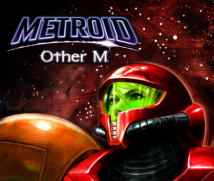3. Over 10,000 Emails Exchanged
All right, I think it’s time for the two people from Nintendo to introduce themselves as well.
I’m Morisawa, from Production Group No.1 of the Software Planning & Development Department. I worked as an art director on Metroid: Other M. I was responsible for creating characters and stages for the game, as well as supervising the concept design of the appearance of the entire game world. I have also worked on other games in the Metroid series: Fusion 12, where I was in charge of backgrounds, and Zero Mission, where I was the art director. This project is the first experience I’ve had of working on a game for a home console, so there were lots of things I didn’t understand. I therefore joined this project with the intention of serving my home console apprenticeship with Team NINJA. 12 Metroid Fusion is an action game for the Game Boy Advance, released in Japan in February 2003 and in Europe in November 2002. It is the fourth game in the series.
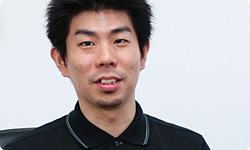
I’m Hosokawa, also from Production Group No.1 of the Software Planning & Development Department. I worked as a director on this project. I’ve been in charge of game design - level design and so on - in the past, on Fusion and Zero Mission, for example. The development themes I’m involved with this time, however, include how much 2D feeling to give the player in a 3D world, and furthermore, how to make the ‘NES game with the latest technology’ a reality by having the Wii Remote held in the horizontal position. From the beginning, this title has had a really strong plot, so...
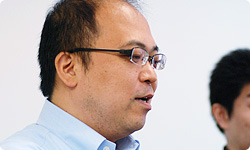
That’s because long before anything was produced, this project had started as a story in Sakamoto-san’s head, hadn’t it?
Exactly. Because of that, I was in charge of pulling the story together, communicating these reorganisations to Team NINJA, and making sure the story gelled. Sakamoto-san was a little bit vague about what he wanted to do at first.
Ah, he does seem like that from the outside, doesn’t he? Sakamoto-san seems to have a specific image of what he wants to do, but he certainly doesn’t express himself clearly. That’s why he is unable to communicate his image from the start so that other people understand. He does have a distinct image in his head, however, so when he’s shown something that’s even a little different to this image, he’s very clear about saying ‘Ah, no. That’s not right’.
Exactly. My mission was thinking of how to communicate this to the people at Team NINJA and Taiyo Kikaku.
Your work involved collaborating with Team NINJA, an external team who boast some real achievements and who have created several masterpieces. Furthermore, you were representing the Nintendo brand. How did you feel about doing this work?
As you can imagine, it was a little bit scary at first. As you said before, Team NINJA, who are responsible for creating some of the best-known action game brands, seemed to be at the opposite extreme to us, and I was anxious about whether things were really going to go well or not. Of course, we had some strong desires that we wanted to set forth, and I was concerned that they wouldn’t understand these desires or that we wouldn’t engage with each other, since in the worst case scenario this could have caused the project to break down completely. From that point of view, I was really anxious.
How long did it take for those worries to be eased?
As other people have already mentioned, all such worries were completely eradicated just by talking to each other several times. Everyone at Team NINJA was really positive in listening to our opinions, and they didn’t just listen, they also came up with a steady stream of new proposals. It was therefore really easy to work with them.
When Sakamoto-san and the team told me about how the exchange between the two companies was going – this was just after the project had started - I remember feeling that: ‘The reason this project is clicking so well must be because there’s a good affinity between Team NINJA and the Metroid team’. With this project, I got the impression that the early stages especially, from the start until the project was really up and running, went very smoothly.
Of course, there were various issues involving minor details, but I got the feeling that the overall flow of the project had been smooth.
Though I did think ‘they have a good affinity’ right from the start, by the last stages of development you had settled in to the extent that I felt ‘I never thought you’d fit in so well’. I mean, most of the time during the second half of development, you were like ‘Sakamoto-san from Team NINJA’ and ‘Hosokawa-san’ from Team NINJA, weren’t you? (laughs)
Yes, that’s right. (laughs) I lived in Tokyo, along with Sakamoto-san, for about three or four months.
You didn’t come back to Kyoto at all, did you! (laughs) You were away for so long, when I met Sakamoto-san in E313, we were practically greeting each other like long lost friends! 13 E3 2010 was a video game trade fair that was held in Los Angeles from 15th-17th June 2010.
They were in our offices so often that we were beginning to think they might be spending more time on the Team NINJA office floor than we were! (laughs)
Now then, Morisawa-san. You’ve worked on the Metroid series in the past, but the games you worked on were for the Game Boy Advance. This project involved 3D CG, which you didn’t have experience of creating, and it also involved linking up with a team of people that had more experience than you did. Having to be the art director in those circumstances must have actually put quite a lot of pressure on you. How did you feel about such things?
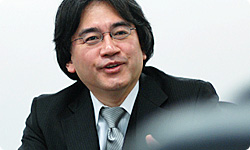
You’re right of course, I did feel pressure. I do have a grasp of the appearance of the world in the Metroid series, but I had never even been involved with 3D technology, never mind with the kind of projects that involve 100 people - the kind Team NINJA take for granted.
So you’d worked in project teams of 10, 15 or 20 people, but never in a team of 50 or 100.
Sakamoto-san just came to me one day and said ‘we’re leaving the design of Metroid to you’. ‘Design’, however, includes absolutely everything from 3D models to motion capture. I didn’t know how to proceed with such things in my work, and since I didn’t have any personal experience, I was really wondering what I should do... When the date of our first meeting with Team NINJA was set, we found out about it a month or so in advance...
So you had some preparation time, then?
Exactly. But at that time I didn’t know what I should prepare. I got really scared, so much so that I couldn’t sleep at night.
So here’s another person who’s been losing sleep! (laughs)
(laughter)
First I decided to compile some documents describing the appearance of the world in Other M, containing the images I’d already made and things like that. Then I showed them to Team NINJA to see what they thought. I was a little bit worried that they might say ‘what’s this all about?’ or that they would react negatively, but actually Team NINJA said they understood immediately. Furthermore, they actually said ‘first of all, we’ll try creating some of this’. At that point I started worrying again, thinking, ‘what can they possibly do with just those paper documents?’. Soon afterwards, however, a moving model of Samus had been created.
Did she seem like Samus right from the start?
She did, yes. Despite the fact that I’d only given them a few documents, our image had been brought to life during this first phase, so I remember everyone being really surprised and saying ‘Wow! This is amazing!’.
Why do you think you were able to do such a thing, Saito-san?
Well actually, I only joined the project several months after it had started, so I wasn’t involved with the very first things that were created. This is therefore nothing more than how I imagine things were, but you can be sure that our designers, Hayashi-san and others did an awful lot of trial and error. As you can imagine, though, everyone had been familiar with the Metroid games for a long time and were fans of the series, so were really interested in it. We felt passionate about being the ones to make a Metroid title for this generation, feeling like 'We want to make this happen! Let's do this!' I think we were therefore able to match Nintendo’s image because we created things after thinking about what Morisawa-san presented to us from various angles and in our own way.
I personally got that feeling from the completed final product as well. I never got the feeling from the game that this was originally two essentially different things that had been forced together.
I think the biggest factor in that was that the basic concepts of the game had been made absolutely clear. When I first met Morisawa-san and had the concepts explained to me, I just dived straight in. The things that they valued had all been considered and coordinated – how do life forms live in this environment, how have they evolved, what kind of ecosystems are created there – that kind of thing.
I see.
And because the basic concepts were clear, I suppose explanations within the team were grounded in theory. Instead of saying ‘that doesn’t look nice’ or ‘that colour’s not very pretty’, they’d really try and understand things like ‘why this needs to be corrected’ or ‘why this is no good’. We weren’t just going on our senses.
Is it the usual custom at Team NINJA to try and think ‘why should it be like that’?
I guess we’ve always tried to make things easy to understand, and also, in our direction, don’t just consider one point, but also how it connects with the next point.
Now then, the visuals for this title, especially, must have taken an awful lot of energy to create, so many people must have poured their own creativity into it. How on earth did you manage to keep the image consistent during such a process?
Well, I think that good communications between each of us was really important, of course. The mailing list was an example of this. When I checked how many emails related to this project had been sent over the last two years, it was over ten thousand.
Ten...thousand?
That is not the total number for the project. Over ten thousand emails were exchanged between the staff related to cinematic production, which I was involved in. This meant that more than a dozen emails were exchanged every day, so we were always communicating with someone or other.
Could you give us an example of the kind of exchanges you had?
For example, we’d send off designs for cinematics, and many times what we’d get back would be criticism from Saito-san: ‘Nagasawa-san, this is wrong. This isn’t Samus’.
So the one who pointed out that ‘this isn’t Samus’ was Saito-san. From Team NINJA! (laughs)
Well it wasn’t just Saito-san, of course. Morisawa-san would say ‘this is wrong’, Sakamoto-san would say ‘this is wrong’, and Kitaura-san would say ‘this is wrong’ as well. (laughs)
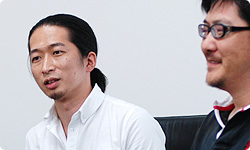
(laughs) So people from every position would say ‘this is wrong’, and every time you would make adjustments to the cinematics, right, Nagasawa-san?
Yes. This didn’t just take place over email either, we’d also have face-to-face discussions. As a result of this density of communication, I think the final design is consistent with everyone’s intentions.
